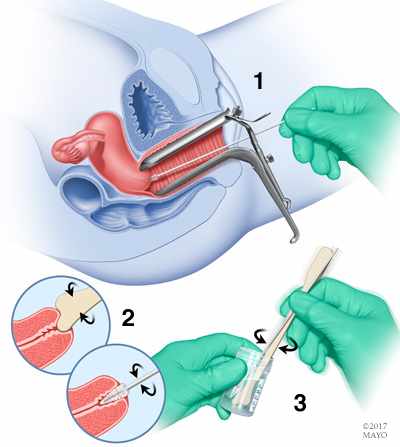
For decades, many women have seen their health care provider for their yearly Pap test to screen for cervical cancer. New technology that also checks for the presence of the HPV means that most healthy women don't need to be screened as frequently.
Mayo Clinic Family Medicine specialist Dr. Kathy MacLaughlin says certain forms of the HPV virus are responsible for most cases of cervical cancer. And if the test shows the virus is not present and cervical cells are normal, most healthy women won't need another screening test for three to five years.
One way to use HPV testing is in a Pap/HPVco-test, basically two tests instead of one when you put the Pap and HPV together. Dr. MacLaughlin says, "This combination led to the reasoning behind extending the interval from three to five years because you essentially have double protection against something being problematic at that point in time and for the next five years. So, you have the protection of knowing the cells look normal, and there’s no presence of human papillomavirus."
Dr. MacLaughlin says,"In the past year or two, we have a new option of the HPV testing alone at 3 year intervals, which became U.S. Food and Drug Administration FDA approved in 2014 and guideline-approved in 2015. I don’t think it’s being commonly done, but it is available at Mayo Clinic in Rochester now, and we’re trying to spread the word about why that might be an option to consider."
Watch: Dr. MacLaughlin discusses Pap tests and HPV testing.
Journalists: Broadcast-quality sound bites with Dr. MacLaughlin are in the downloads.
Dr. MacLaughlin explains, "HPV, we now recognize, is the cause of 99 percent-plus of cervical cancer changes in cases. And, so, the idea behind checking for HPV is that, if HPV is not present, then that patient would be at very low — almost zero risk. But if it is present, they are at increased risk, with the caveat that most HPV infections do clear in time in about 70 to 90 percent of the cases within a couple years."
"So we’re looking for cancer of the cervix, which is usually called a squamous cell cancer. There’s also an adenocarcinoma that’s less common, but they’re both cells from the cervix that you can see in stages of change, of precancerous change up to cancer," says Dr. MacLaughlin. "And, many times, the low grade or mild changes will regress or clear without any intervention, but they also, over time, could progress to something more concerning. So screening works if we do it regularly at regular three-year to five-year intervals."
"HPV, we now recognize, as the cause of 99 percent-plus of cervical cancer changes in cases. And, so, the idea behind checking for HPV is that if HPV is not present, then that patient would be at very low — almost zero risk. But if it is present, they are at increased risk, with the caveat that most HPV infections do clear in time in about 70 to 90 percent of the cases within a couple years." — Dr. Kathy MacLaughlin
"The newer use of the higher risk HPV is just by itself as a three-year interval screen," Dr.MacLaughlin explains. "It's felt to be a reasonable option for women who are 25 to 65 years old, and if they have a negative high-risk HPV test, then they would come back in three years and just repeat that again. If they have the type 16 or 18, they would have a colposcopy, and if they had one of the other 12 types positive, they’d be brought back in a year for a recheck."
"So it’s kind of the reverse of Pap – that might have an HPV test added based on certain Pap results. It's an HPV test that might have a Pap added, depending on the results. It’s a really new concept kind of a reverse concept. But you’re really screening for the root cause of the cervical cell problem." Dr. MacLaughlin adds, "I am a fan of the combination Pap/HPVtest, the five-year combo test. That’s approved just for 30 to 65-year-olds. The potential downside of using the primary HPV for 25- to 29-year-olds is that, although you will pick up some increased precancer, the studies done were of short-duration and didn’t really prove that you would change long-term outcomes by starting HPV screening sooner than age 30." She continues, "You could have found that positive HPV result at age 30 with a combination test. It's a very slow progression from precancer to cancer, and in the studies where they looked at doing this test in younger women, it doubled the colposcopy rate because HPV is so common."
Dr. MacLaughlin adds, "I am a fan of the combination Pap/HPVtest, the five-year combo test. That’s approved just for 30 to 65-year-olds. The potential downside of using the primary HPV for 25- to 29-year-olds is that, although you will pick up some increased precancer, the studies done were of short-duration and didn’t really prove that you would change long-term outcomes by starting HPV screening sooner than age 30." She continues, "You could have found that positive HPV result at age 30 with a combination test. It's a very slow progression from precancer to cancer, and in the studies where they looked at doing this test in younger women, it doubled the colposcopy rate because HPV is so common."
"I do try to individualize for people what their personal risks are," says Dr. MacLaughlin. "So if they are smokers, we know that they are less likely to clear HPV, though it doesn’t change their screening recommendation. But I use that as a motivator to quit smoking. We have really great evidence that for healthy, nonimmunocompromised women, if you do regular screening, whether it’s every three years with Pap or HPV testing alone or every five years with combo Pap/HPV testing, you’re really going to catch things in a stage where it can be treated and not progress on to cancer."
Watch: Mayo Clinic Minute: Pap test recommendations
Journalists: Broadcast-quality video pkg (0:59) is in the downloads. Read the script.







